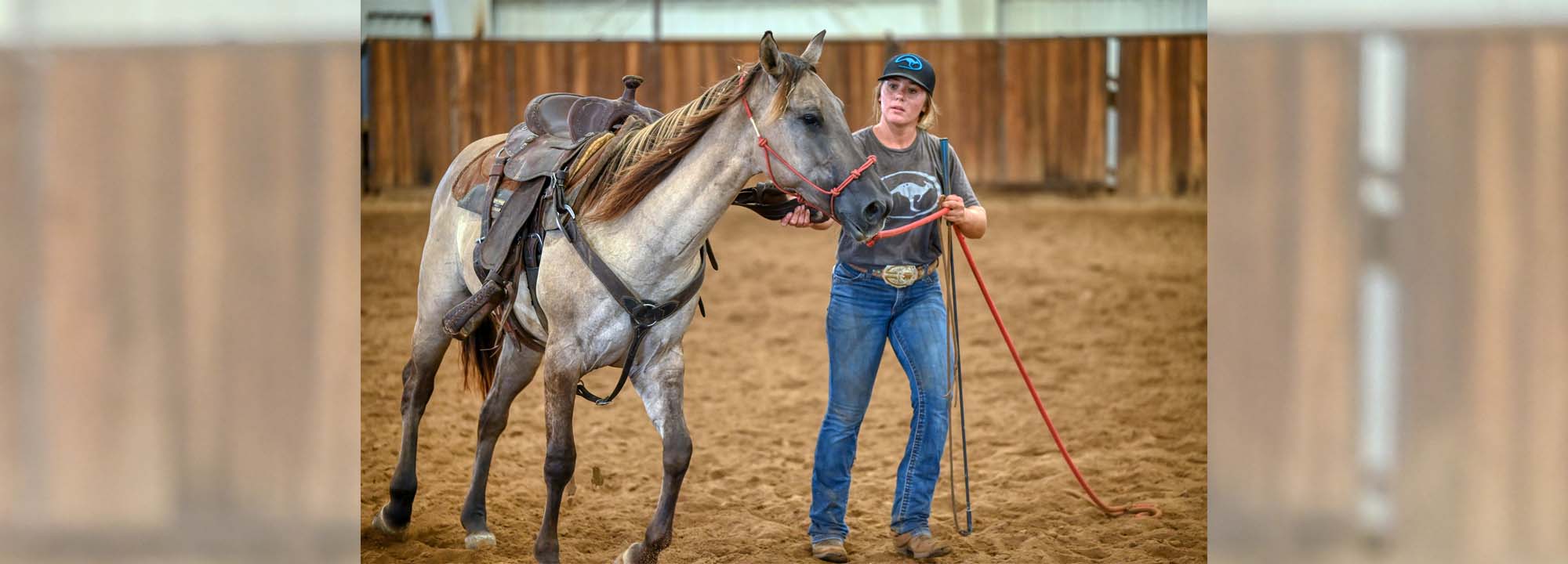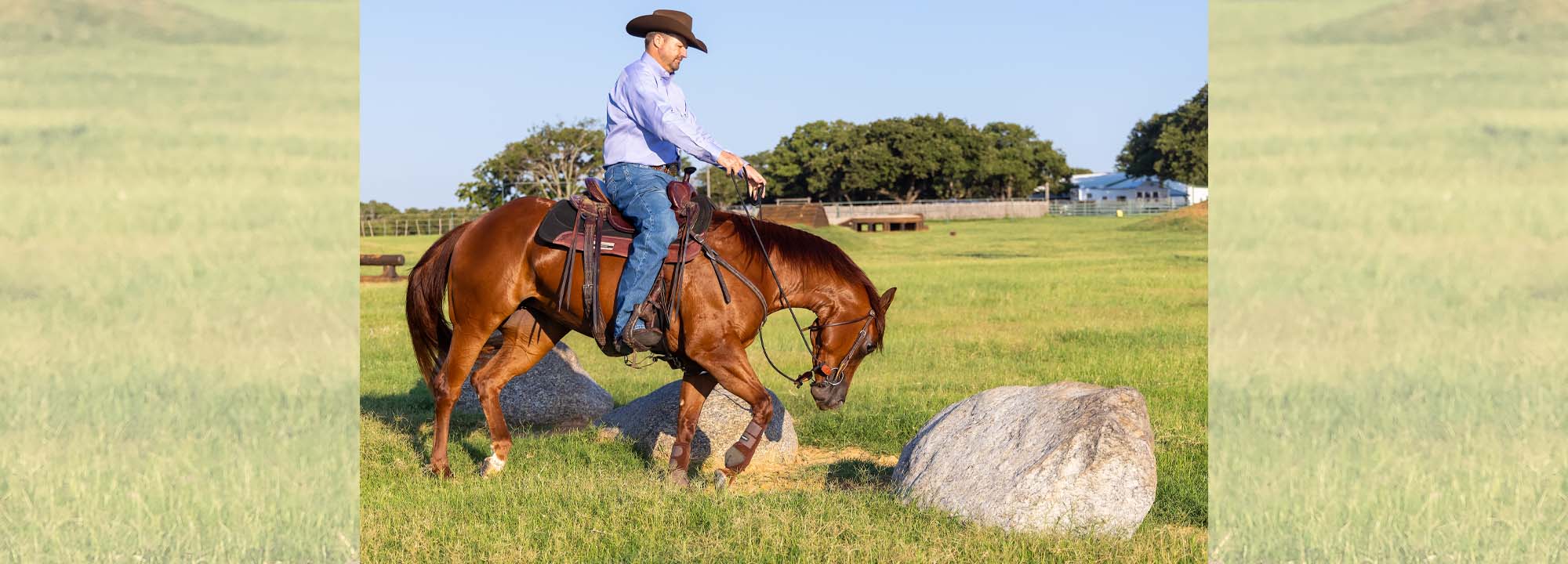Question: We have a 5-year-old gelding that has been recently gelded. He has been through the Fundamentals groundwork and he did really well. If you ride him for consecutive days, he does not saddle up cinchy. If you leave him for a couple of days and saddle him, he bucks, he rears and he lies down. What would you recommend that we do to get him over that issue? – 4horsemanship
Clinton’s Answer: I’d start over. He’s telling you that you’ve got some major holes in your foundation and he’s not comfortable with the saddle. When it comes to saddling horses for the first time, you have to be extremely detailed. You cannot miss any steps, and once you’ve saddled them for the first time, you need to consistently work on it; you cannot miss a day or two. That’s why in the Colt Starting Series, I tell people to work with their horse every day for the first 14 days.
When a horse does something once, it plants a seed. When he does it again, it becomes a habit. If he does it a third time, it becomes an ingrained habit. If it’s a good thing, it’s a good habit. If it’s a bad thing, it’s a bad habit. Every time your horse has reared, bucked or lain down, it’s become a more ingrained habit. The more ingrained the habit, the better horseman you have to be to fix it and the more consistent and diligent you have to be with your training.
With your horse, go back and do nothing but groundwork with him for a week. Making sure he’s solid at all of the Fundamentals groundwork exercises will ensure you’ve got his respect and that he’s using the thinking side of his brain.
Then start to desensitize him to pressure around his belly using the lead rope. Loop the lead rope around his barrel so that it’s right behind his shoulder where the cinch will lie. Using both of your hands, pull up on the rope with one hand and down on it with the other, gently squeezing the colt’s barrel. The pressure will simulate what the cinch is going to feel like. Hold the pressure until the horse stands still and relaxes. When he does, release the pressure. If he moves around, keep the pressure in place and follow him wherever he goes. Practice this for a few days until every time you apply pressure, he keeps his feet still and stays relaxed.
In the next groundwork session, after you’ve got him tuned in to you, put the saddle on him and thread the latigo through the ring once. Pull up on it so that the girth tightens against his side. Wait for him to relax and then release it. Repeat that process of pulling the latigo up and undoing it seven or eight times.
Then do the last thing that he’s expecting—take the saddle off him. Once the saddle is off him, go practice some groundwork and get his feet moving. After a few minutes of making him hustle his feet, put the saddle on him again and go back to applying pressure with the latigo and girth.
When the saddle comes out, your horse thinks it’s going to be a fight. You want him to start identifying the saddle and the girth with something pleasurable. When he’s huffing and puffing a little bit, he’s looking for a rest. You’re going to show him that the only way he gets that rest is when you put the saddle on his back and do up the cinch.
Repeat that lesson for as many sessions as it takes for the horse to get comfortable with it. It could be two or three days, or it could take a week. Take the time that it takes. When he’s ready, saddle him and do the girth up so that it’s just snug against his side. Step back away from him, and yield his hindquarters to get his feet loosened up. Put just enough pressure on him to get him to move his feet. Then get to the center of the roundpen and ask him to trot around you. If he tries to buck or rear or lie down, immediately slide your hand down the lead rope, step out in front of the drive line and get him to change directions.
Let the colt trot around the roundpen a few times, and then yield his hindquarters to bring him to a stop so that you can tighten up the cinch. Don’t ever put the saddle on and do the cinch up as tight as you can from the beginning, because that’s a good way to make a horse cinchy. Always do it up in stages. When you send the horse back out on the circle, get him cantering. Again, if he goes to buck or rear, immediately step out in front of him and get him to change directions.
When the colt is cantering around the roundpen relaxed, the best thing to do is to turn him out in a safe arena where he has plenty of room to move his feet. You want to let him just get used to wearing the saddle. The key is making sure he moves around. If he just stands in the corner of the arena, it won’t work.
Leave him turned out with the saddle for six to eight hours. If he’s still snorting and bucking with the saddle, leave it on him all night. Put some hay and water out in the arena and leave him alone. The secret is to not take the saddle off until the colt is ignoring it. From this point forward, consistency is your biggest ally.
From the time you put the saddle on the colt, I recommend working with him for 14 days straight. The biggest mistake people make with these young horses is saddling them for a day or two and getting them comfortable with the saddle, and then leaving the colt alone for four days. When they come back to him, it’s like they have to start all over because he wants to buck with the saddle. Or, some people will put two good rides on the colt, and then not mess with him for a week. Then when they come back, the colt dumps them on their heads. Inconsistency will always get you into trouble. Try to plan your schedule so that you’re able to work with the colt for 14 straight days from the time you saddle him.
Have a horsemanship question or looking for more training tips? Check out the No Worries Club.





